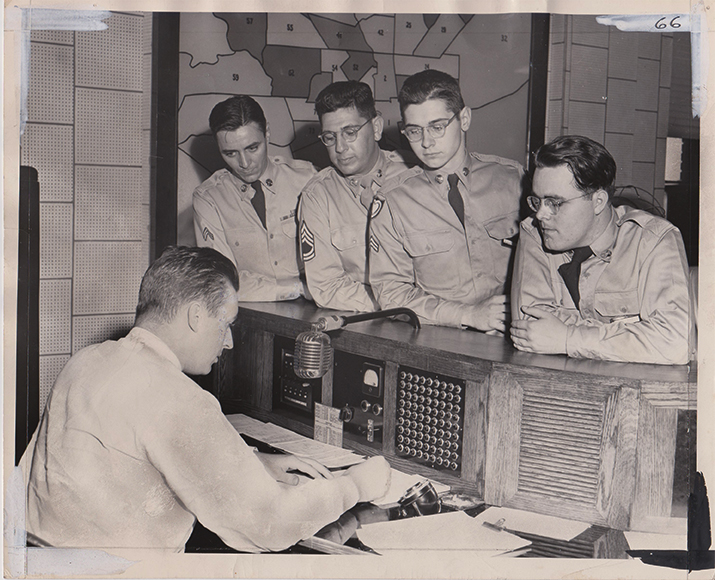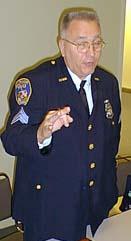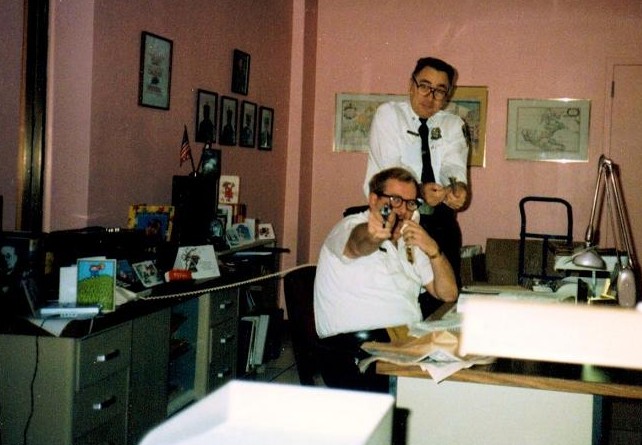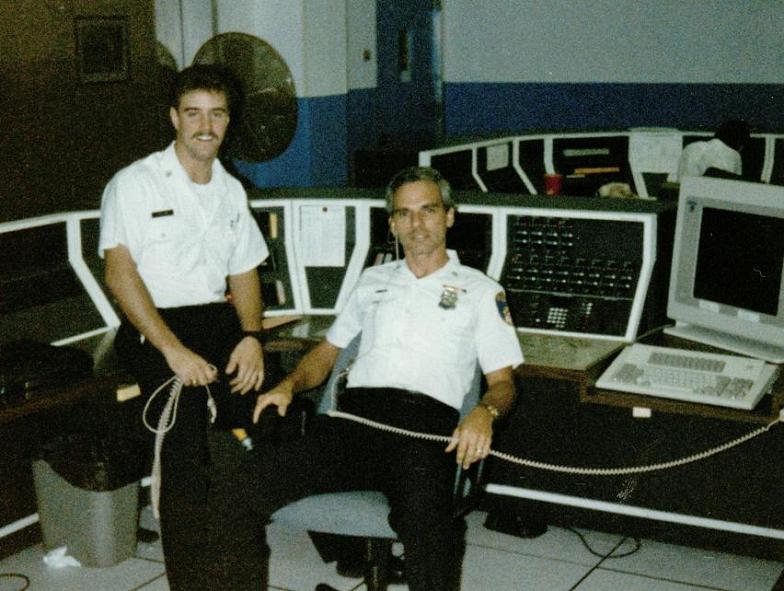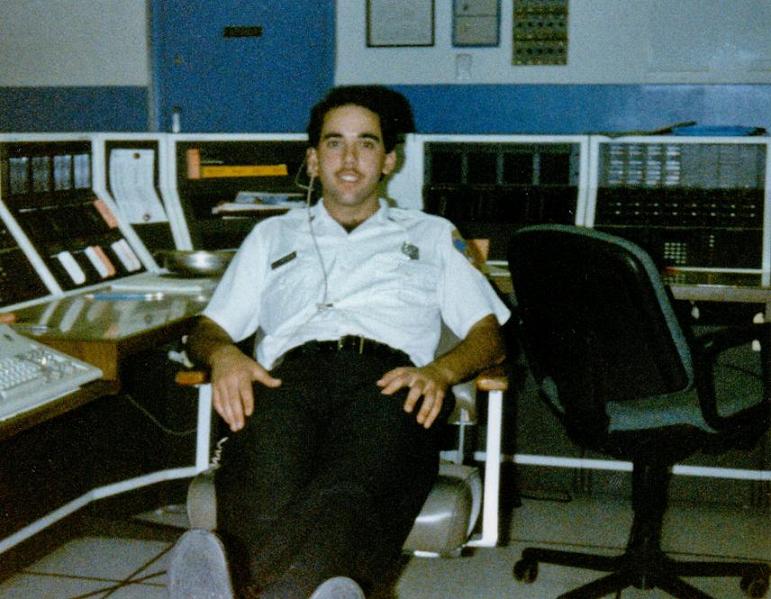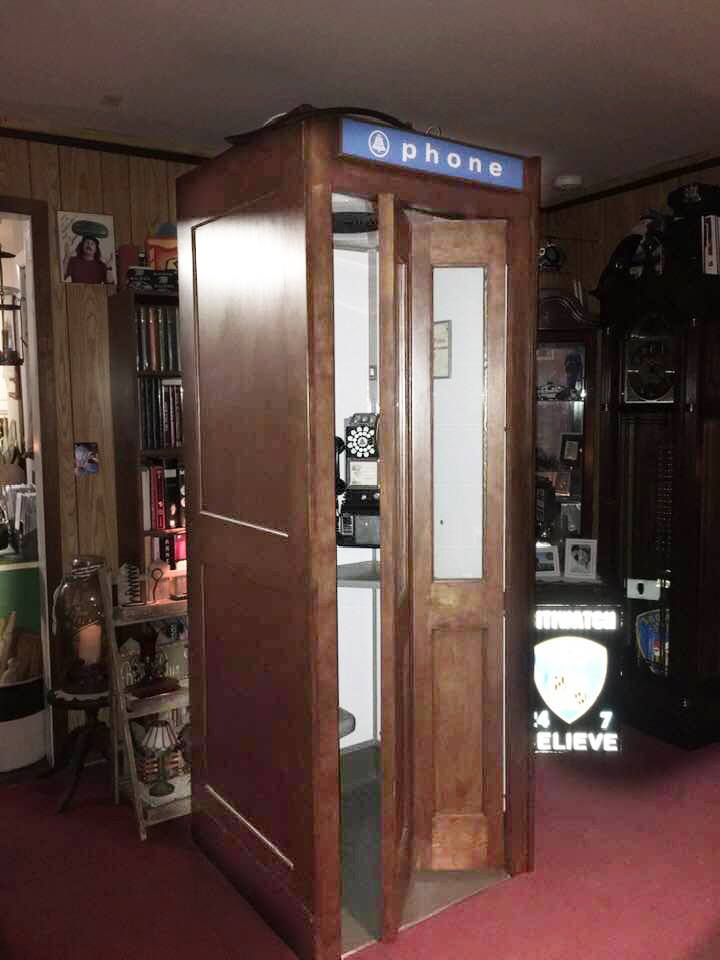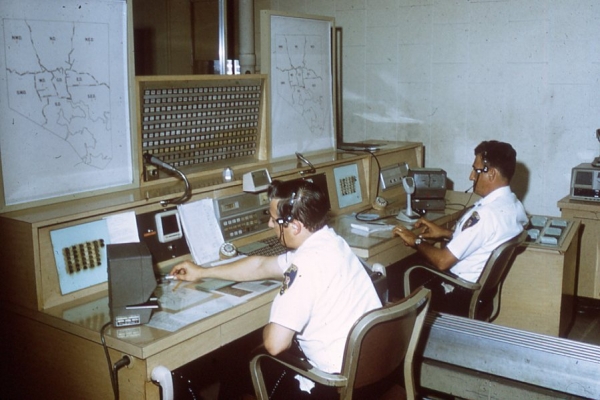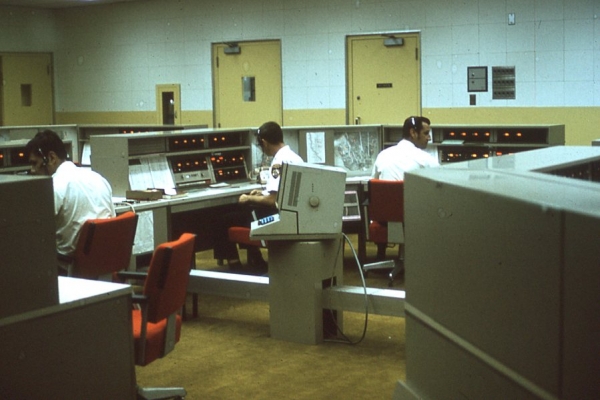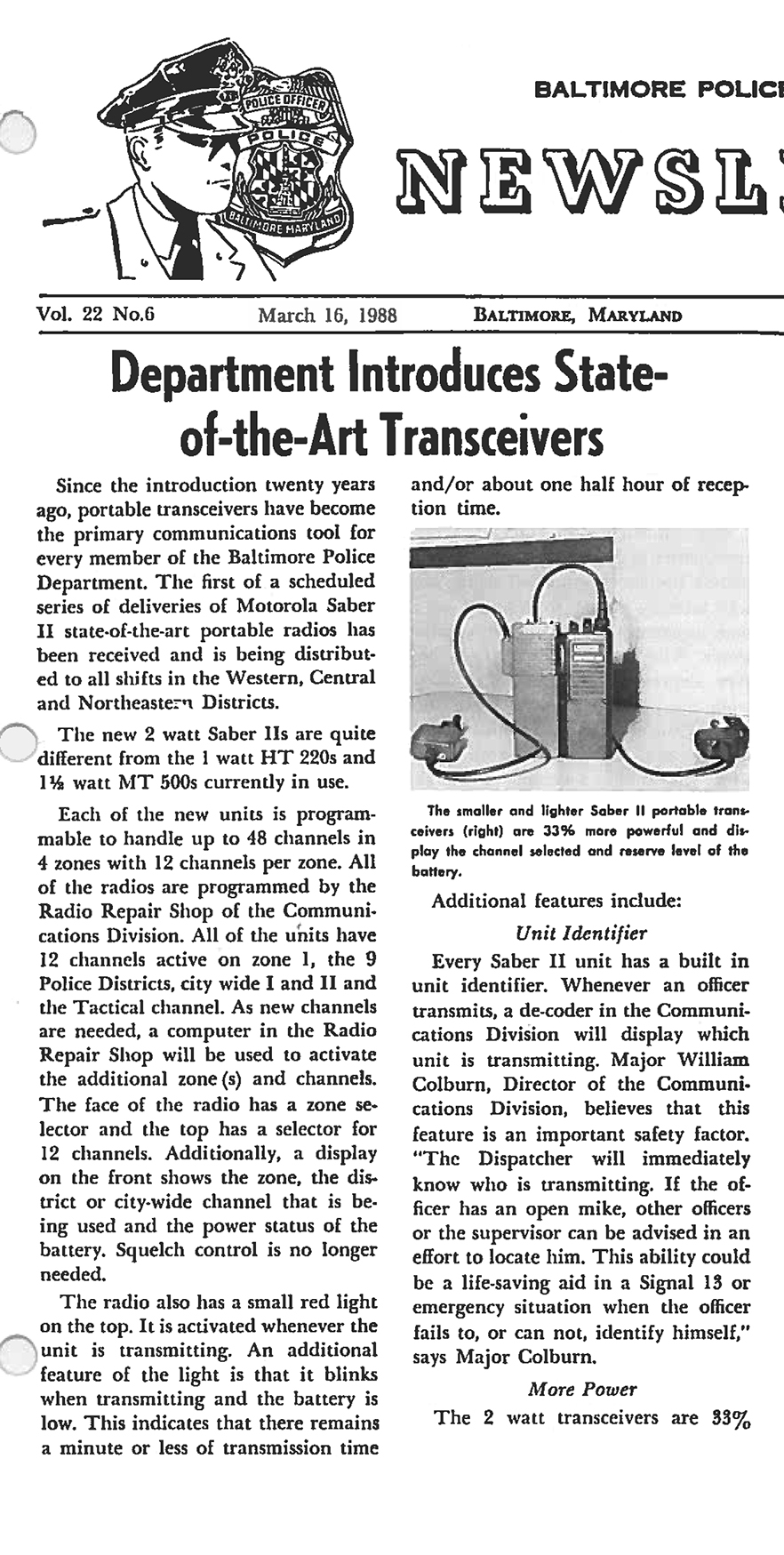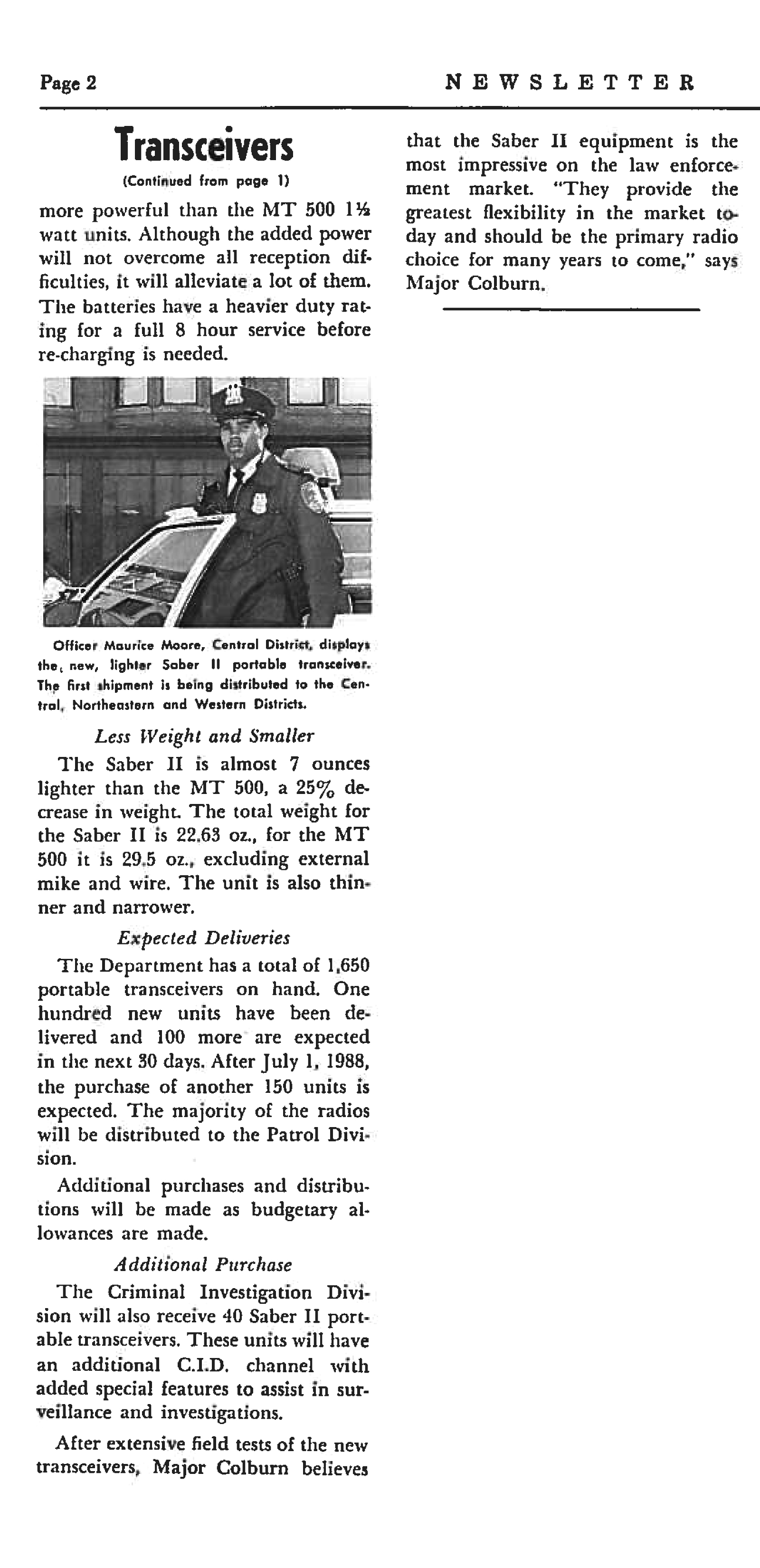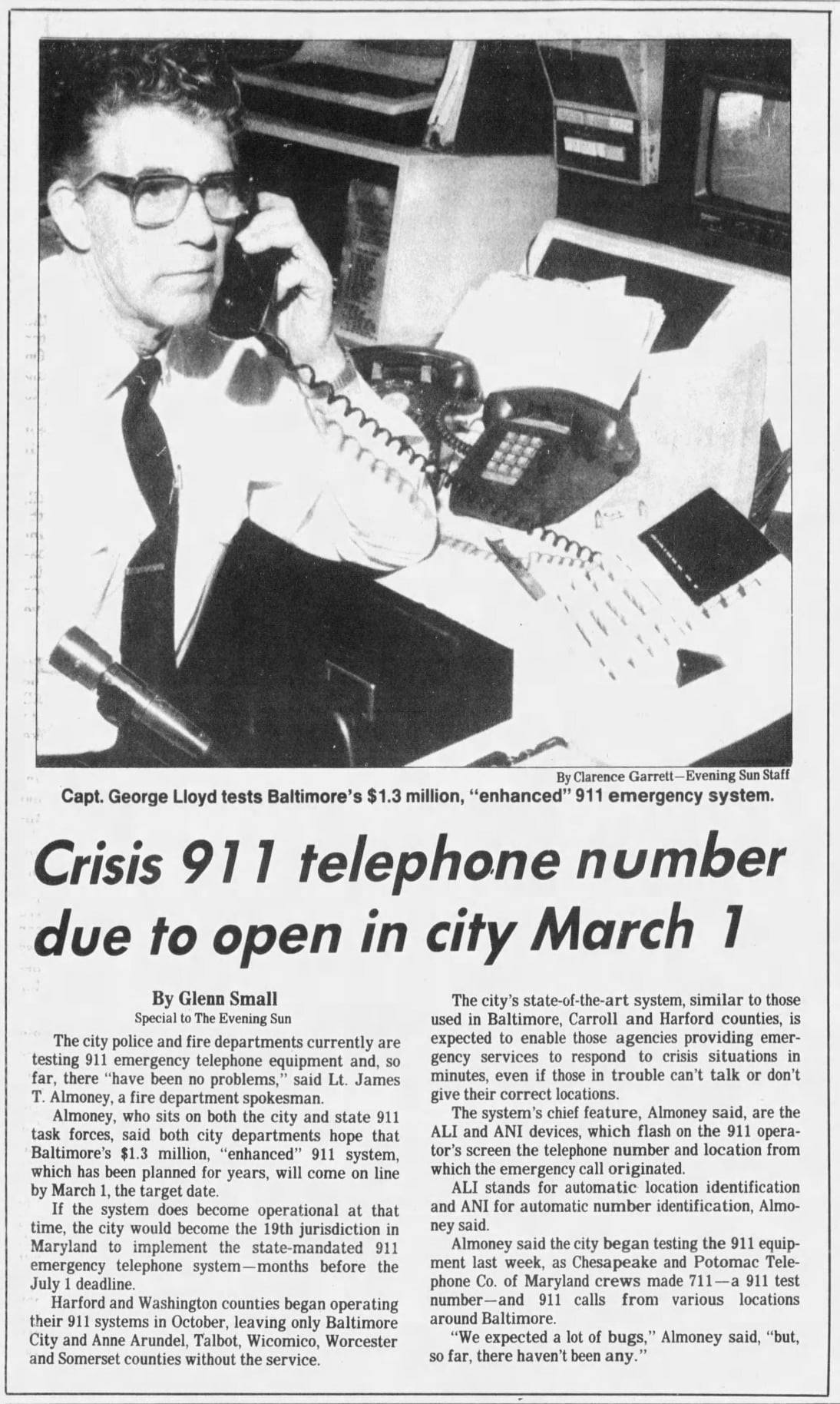Communications Division
In September of 1931, two years before Radio Car Communications would go into effect Commissioner Gaither would approach the Board of Estimates with this idea, here's a Sun paper Article talking about the plans. On 4 May 1933 Our Radio Communication was established, it was the first radio communications system between Patrol Vehicles and a Central Dispatcher
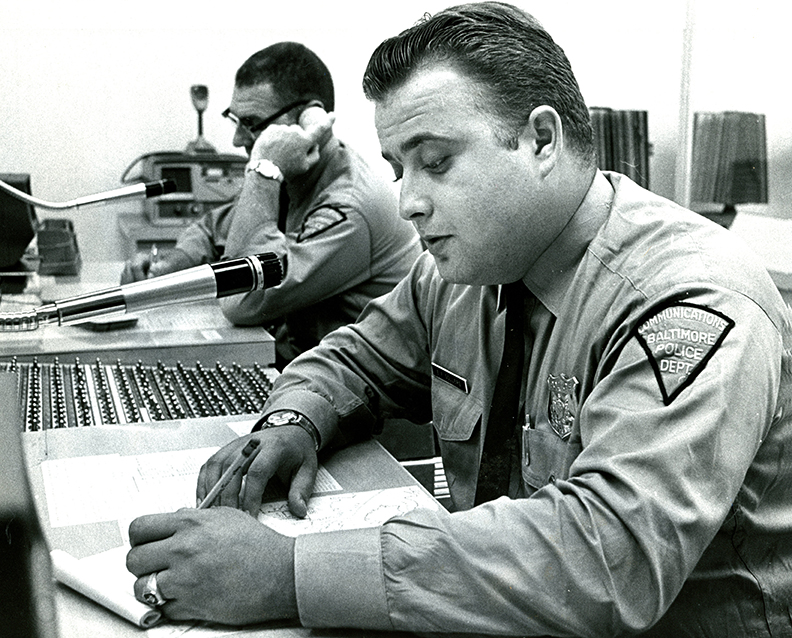
Baltimore Sun Paper
27 September 1931
RADIO EQUIPPED POLICE CRUISING CARS ARE CONSIDERED HERE
by Avery M’Bee
Quick communication with far-flung forces always has been a most pressing police problem. When the Baltimore Police Department a decade ago pioneered the all-around call system of box lights, it was thought that the final word had been spoken; lights at police boxes flashed, and within a few minutes patrolman on every beat were listening to instructions from headquarters. At that time the Baltimore Police Department or proud hosts to numerous official visitors who studied the system with admiration and return to their cities convinced that the police millennium had been reached. Another of the city’s “Famous First” had appeared and almost every city and village in the country adopted the idea.
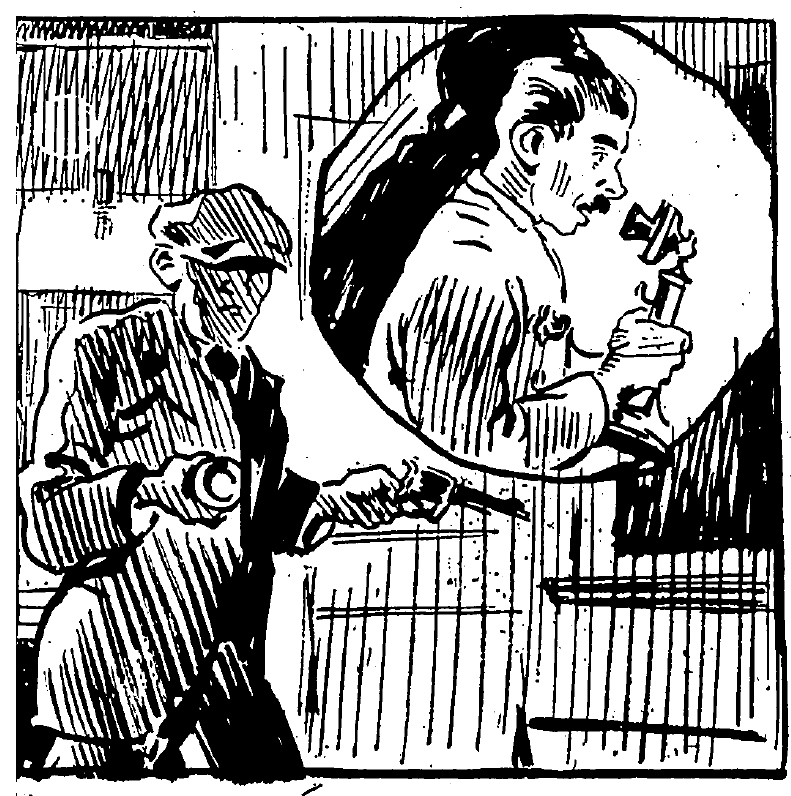
SECONDS NEEDED NOW
But the millennium had not been reached. Because the criminal is among our most progressive citizens, police officials have come to realize that the second row is just as important in emergencies as the minute was when they led the way with the citywide call box recall lights. The last word now is radio communication with a squadron of fast patrol cars always on the alert and fully prepared to handle any emergency. It was not given the Baltimore to develop this system upon the foundation she had laid, but police Commissioner Charles D Gaither is making a definitive move to obtain this ultra-modern method of split-second communication, which he believes will discourage criminal activity because of its ability to pick up a trail almost immediately. The Commissioner has petitioned the board of estimates for funds with which to equip a fleet of cars and to install and headquarters a shortwave broadcasting set. Accounts of the work of the radio-equipped squad cars and other cities are nothing short of marvelous. Stories of told of stolen cards recovered before their motors are really warm, of criminals caught in the very act, of holdups frustrated rather than a then.
WORK REMARKABLE
If there is one element that stands out more remarkably than any other in successful crimes in the last few years, it is time. Your modern Fallon has developed a sense of timing that has given him a tremendous advantage, and he has used the latest products of science in making his getaway. He robs or murders coldly, with the full realization that so many minutes remain before police can be notified and can pick up his trail. The most successful crimes have been the boldest yet not necessarily the most reckless. Sneak thievery pays small dividends and safe braking is tedious. Broad daylight a crowded street to furnish plenty of confusion, a fat payroll and a get-away well planned is the favorite set up of the modern malefactor.
THE TIME ELEMENT
But time is the outstanding hope of success. The holdup man now must reckon with a precision which police believed to be well-nigh impossible. He must break through a mobile line all while information about him is being spread even as he is trying to penetrate the cordon. Buffalo recently instituted the radio equipment patrol cars, the writer interviewed police Commissioner Austin Roches, who declared that amazing reports come to him every day of the works of his radio squad.
AMONG THE FIRST
Among the first cases to be handled on the inaugural day of the Buffalo system was that of a wife beater. It is recounted that the woman, badly mauled and mangled to reach a telephone remove the Hulk and call for police the telephone operator pass the information along to headquarters, immediately it was placed on the air. The nearest radio car turned quickly into the alley behind the house just in time to see the man descending a fire escape. Alarmed because his wife had called into the telephone, he had abandoned the assault to make good his escape. The radio squad was waiting for him when his foot touched the bottom step.
PROMPT ACTION
“I could cite numerous cases of this kind.” Said Commissioner Roches. “They seem a little hard to believe, it is not difficult to understand how things of this sort happen. It must be remembered that the only delays in our action are dependent upon the information we receive from the scene of the crime. At this extension, the radio broadcast operator is “cut in” on all information. In an instant every patrol car in the city has the information” another incident of buffaloes and all Grove date was one of a housebreaking a neighbor made a report to headquarters and through the loudspeaker and the cars came these instructions, “squad car number three go to blank Street; man was seen entering store.” The car was less than a block from the address at the time. The driver slid to the curb while the others jumped from the car quickly covering all exits, they closed in and had corner deceived almost before he had time to begin his work. Every day, according to Commissioner Roches automobiles are reported stolen, their license number passed on to the radio squad cars and the culprit arrested before they have gone a dozen blocks. From Detroit and Chicago come reports of holdup men attacked before they even have time to start their getaway – taken with their loot and in the presence of those who witnessed the crime. “Take some of our own outstanding crimes, for instance.” Said Commissioner Gaither. “What chance with the Norse murders have had to scatter as they did? Suppose we had had the city covered with radio cars at that time. At the first tipoff of the nearest car would have been on its way at full speed to the scene, while all others would have increased their patrol rate and would have been on the alert for the bandit's automobile. We would have been able to pour additional information into the cars as a came to us, while they were on the lookout for the bandits. As it happened, we round up that gang in time, but at what cost? “The same thing would have applied to the killing murders. The sunny born holdup and many other cases of murder and banditry that has stirred Baltimore. How quickly could we have frustrated the North Avenue bank holdups? One can well imagine how expeditiously the police could act on an automatic alarm if we were able to reach instantly a carload of armed men who are sure to be patrolling a short distance from the scene.”
MONEY-SAVING CITED
“Arab men have done some remarkable work in apprehending criminals after staring crimes.” Mr. Gaither continued “in the cases mentioned only the highest praise is their lot. But think of the time and manpower the money that was spent in clearing up those cases! “I truly believe that the city would save a great deal of money with radio cars. More important than that, I think the criminals would be restrained by the knowledge that such a powerful weapon is being used against them."
WOULD AID SYSTEM
“Our old Pioneer all around system was good as it ever. It is by no means out of date, for there are many things it can do now that are entirely out of the line of the radio quipped automobile. It is necessary for us to keep in constant touch with our patrolman: to give them information and instruction. It would work in splendid playing with the newer idea. But we need some means of swift communication with the force that can act on the second – that can meet an emergency when it arises and yet take care of routine duties as well." - "One of our troubles now an emergency case is that we cannot coordinate our efforts as we would like to. In case of a holdup or murder, armed men get the information over and all around and, not being sure how well the matter is being covered. They hurried to the scene from all directions. Being pulled from their beats when they might do more good to stay on them. In such cases, everyone available is rushed to the scene. Often, when I get the information, I go myself not being sure that someone with the power of direction is present to handle the matter."
MATTER OF MINUTES
“With radio cars we could be assured that the scene is covered in a matter of minutes; that our other cars are on the lookout, and we would use all around to put all police eyes on the watch in their own belly wicks and thus any malefactor” Observation of the radio car system and other cities has shown not that it uses lies only in emergencies but that the cars can cover a multitude of routine duties door in the course of their patrol. Of course, their most conspicuous service has been in holdups, murders, robberies, riots and in recovering stolen cars, but they frequently are used to transmit important information in a hurry. To investigate complaints that would not interfere with their patrol and to serve as an additional link between headquarters and a patrolman on foot.
SERVICE EXTENDED
In other cities where the radio patrol cars are in use the services being extended greatly outside the corporate limits. State, county and neighboring town police are equipping their prow cars with the radio to pick up the broadcast from the larger centers. Buffalo, for instance, sends out its information now to a dozen villages and to the state troopers on patrol of county roads. In this way and the outer cordon is wrong and the evildoer has one more threat to face. The practice generally followed by police using the radio equipment automobiles is to divide the city and to tangent beats. Each car works in its outer circle until it receives instructions to follow up a happening within these bounds. If a crime has been committed. The other cars continue on their beats and faster time. Leaving the machine on the beat to rush to the spot and pick up the trail at the scene of the crime.
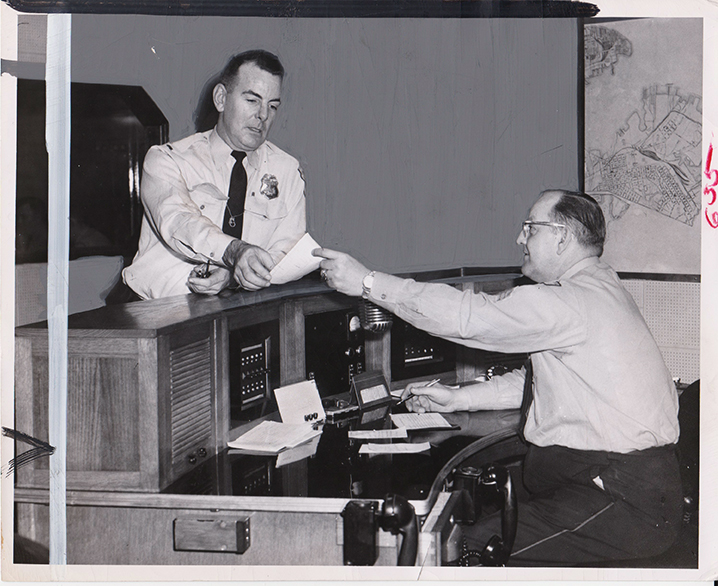
ANOTHER VIEW
Buffaloes Commissioner had some interesting remarks in this connection on the criminal and his getaway: “it’s almost impossible for men who committed a crime to proceed circumspectly while making a break” said he “ involuntarily they put on speed, whether a foot or on wheels. Ordinarily, a policeman thinks little of a car traveling above the legal rate" – summary drivers are a hurry. But in one of our motor squads has information about a felony just committed, it is immediately suspicious of any unusual haste. "In the swirl of traffic or in the crowds on the sidewalks, the man in a hurry makes himself conspicuous immediately and he is some quietly subject to close scrutiny. Our ability to disseminate information as soon as we get it right’s guilt on the speeding car or hasty feet.” An intermediate step between the all-around call system and the radio-equipped squad car was taken some time ago by the Baltimore Police Department when installing telephone typewriter in all of its police stations and at headquarters. With this method of inter-communication between all police concentration points, an operator at any point can post all districts immediately on happenings of unusual interests. The operator assisted the typewriter and writes out the information he has on hand. At the same instant the characters form on the sheet in front of him, they appear on typewriters in all the police stations. In this way, follow-up data and corrections can be forwarded to all points at once, while replies or quarries are possible, since an operator at any receiving point may sit at his typewriter and convert his machine into ascending instrument
WIDELY USED
Telephone typewriter idea is being applied throughout the country and many officials believe that eventually the police of the entire country will be linked by this method. New York State had just completed a network by which all police departments in the state and all state police barracks are interlinked by the telephone typewriter. Plans also are being made to connect the system to those of Massachusetts, Connecticut, Pennsylvania and New Jersey. This compares with the old custom of sending telegrams helter-skelter by hit or miss means, without the ability to provide full descriptions or follow-up information. Baltimore now has an efficient inter-district line of communication and the best possible means of reaching its foot patrol. Commissioner Gaither now is seeking the ultimate in communication a flying squadron instantly informed and ready to act on anything that may occur
KGA 410 March 4, 1933
 The Baltimore City Police Department
The Baltimore City Police Department
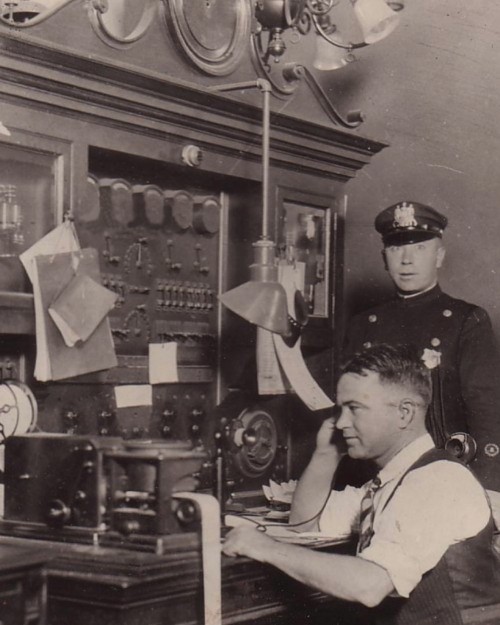

The first digit is the district, the Second character is the shift, third is sector and fourth is officer's post. 6A32 would be a 6 = Northwest A = a Midnight unit in 3 = Sector 3 on 2 = Post #2 and 2C23 would be 2 - Southeast C - Evening shift (3x11) unit in 2 - sector 2 on 3 - post 3. Lieutenants are 09 and Sergeants are 10, 20, 30, etc., 91 and 92 are wagons and 99 is the desk. So, 2C23's Sergeant would be 2C20 and his Lieutenant 2C09. If a unit gets a warrant confirmation from 2C99, then 2C91 or 2C92 would do the transport. 200 would be the district's Major. Flex and District Ops units are numbered differently. They are numbered for each district as *1** and *2**. Northwest be something like 6117 or 6234. Again any number ending in 0 is a Sergeant and 09 a Lieutenant. Any numbers over *3** are Citywide units.
58xx is Crime Lab
84xx is Accident Investigation Unit
64xx is Homicide
65xx is Violent Crimes Task Force
76xx-78xx is Tactical (including Marine, EVU, and Canine)
7620-7625 is Foxtrot
7811-7812 is EVU
93xx is Parking Control
95xx is Traffic Enforcement Section (civilians that direct traffic and write tickets)
96xx is Baltimore City Sheriff
97xx is Housing Authority of Baltimore City Police
98xx is Baltimore City Sheriff
99xx is Baltimore City Public Schools Police


 Click HERE or pic above to see full size article
Click HERE or pic above to see full size article
The Old Oaken Phone – Desk to be Memory
22 Nov 1948
Frequenters of Baltimore police stations may shed a tear for the venerable oaken desks at which stationhouse telephone men work. The desks, according to late reports, are soon to join the open, horse-drawn paddy wagon and old-time tall helmet in obscurity.
Their place will be taken by shiny all-metal desks, streamlined and efficient. The first, built by the telephone signal division of the Police department, has already been installed at the Southwestern station and is now in operation.
BUILT IN CLOCK
As rapidly as possible its counterpart will be placed in each of the other seven stationhouses.
The new model features fluorescent lighting and a bult-in-clock. It has a simplified twelve-key panel, aglow with lights, by which the telephone man keeps in contact with patrolmen on beats and with other police units.
On the new model, the tape, on which time and signals are recorded when a beat man dials in from his call box, runs horizontally across the desk at eye level. On the old model the tape ran a devious path from the side of the desk down, to the bottom drawer, at which point it disappeared inside.
AGE OF FM RADIO
In this age of FM Police Radio, police laboratories and progressive traffic lights, the days of old oaken telephone desks are numbered.
Perhaps the traditional brass rail before which wrongdoers are haled to be booked will be the next to disappear.


911 How It Works
By Public Affairs Office
Thursday, July 16, 2009; 8:14 am
"Baltimore Police 911. What are you reporting?"
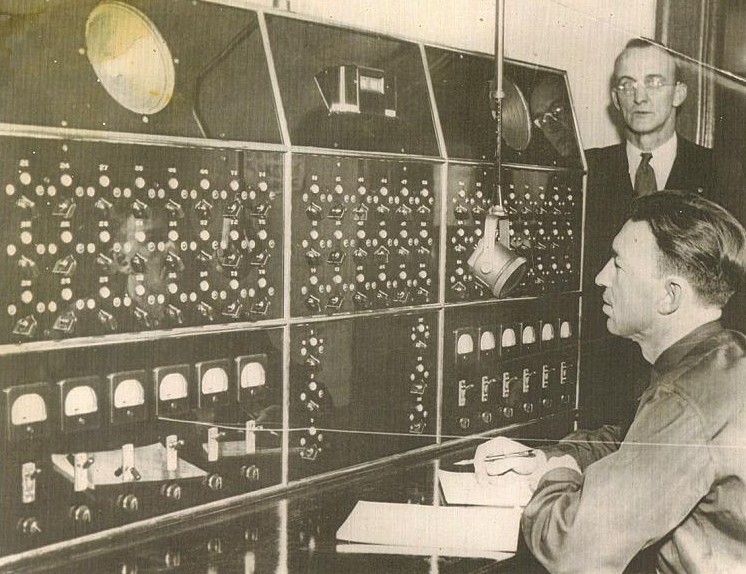
1960's Communications
Here are some tips for calling 911. Reading these now may help you when an actual emergency occurs.
- Remain calm
- Be prepared to verify phone number and location
- Be brief · Answer all questions
- Do not hang up
- Be prepared to give descriptions and license numbers
Remember: Answering questions does NOT delay the dispatch of assistance. A dispatcher is sending help your way while the Call Taker takes additional information from you. The more pertinent information you give us, the safer everyone will be. About 911 hang-ups: Our policy is to respond to ALL 911 hang up calls. If you change your mind about needing assistance, stay on the line and explain that to your 911 Call Taker. Otherwise, an officer will be dispatched to your location to ensure that you are safe. Playing on the phone puts those who do need immediate help in danger and puts you in danger of being prosecuted for making a false report. It is a simple matter of explaining to your call taker, you mis-dialed, or changed your mind.
MORE TIPS
1. Stay calm. Speak clearly. Emergency units (police, fire or ambulance) rely on the information you give to get to you as soon as possible and to be able to help you.
2. Give your address and phone number. Many 911 systems automatically display your address, but most cellular phones do not. Your address is vital information. We cannot help you if we don't know where you are.
3. Quickly and briefly describe your problem. As soon as we know what you need, we will know who (police, ambulance, fire) to send to help you. Get to the point as soon as possible.
4. Describe yourself. Tell the 911 Call Taker where you are and what you look like, including what you are wearing. We want officers/medics/firefighters who are arriving on scene to know who they need to contact and for police, we need to be able to tell them that you are not the suspect.
5. Listen to the 911. Call Taker, answer their questions and follow their instructions. Remain on the line until the 911 Call Taker says it is okay for you to hang up.
6. Remain calm. And Again remember Your Call Taker, will have a lot of questions, but they will learn quickly in the early stages of your call who you need, and that unit (fire/police/medic) is on the way, as the call taker is briefing them on the situation. Don't become upset thinking help isn't on the way until after all the questions are answered, help is on its way. The reason more questions are being asked is to determine what if any other units are needed. Will medics be needed, will additional police be needed, in the case of a fire, will it be a multiple alarm fire, etc. Often callers will become upset with their call taker; there is no need for doing this, the call takers want nothing more than to assist you, and to have a positive outcome on your call. So he or she will have a lot of questions for you. The more calmly you answer those questions, the more likely we are to have a positive outcome to your 911 Call.

Radio communications system designed by Lieutenant William Taylor, standing left in the background
.
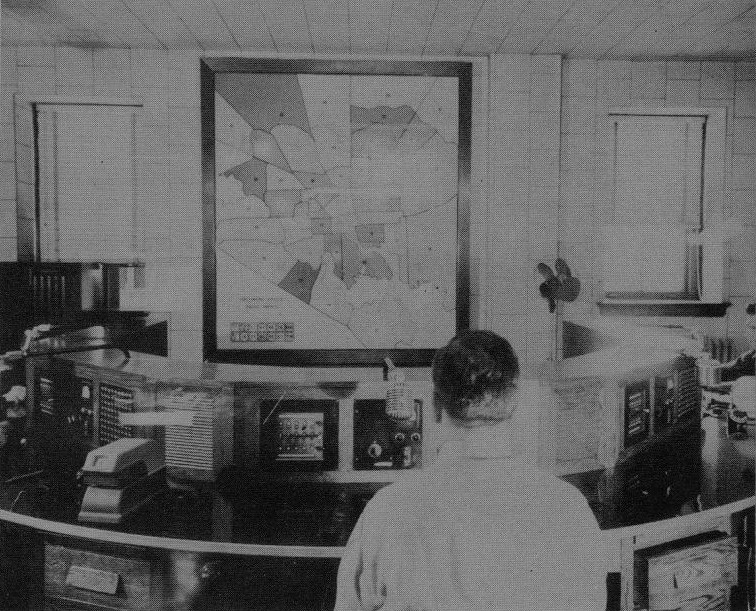

Massive antennae on the roof of the Police Headquarters building 1955

The Baltimore Police Radio System
Explained Example of Modern Police Protection by Radio
4 August 1933
By Oscar McClellan
In equipping the city of Baltimore with the police radio system, Gen Charles D. Gaither, who has been police commissioner of that city for 13 consecutive years, has established a system which may well be taken as an example by other big cities of the United States, and for that matter, cities of foreign countries. With the able assistance of Sergeant William Edward Taylor, supervisor of the radio system, he has inaugurated many unique and efficient features which makes for a maximum of protection at a minimum of the expense. It is interesting to note that since 4 March 1933, up to the present time, the average time consumed in answering police radio calls has been two minutes, 14 seconds, which we believe to be the best performance ever obtained by any police radio system.
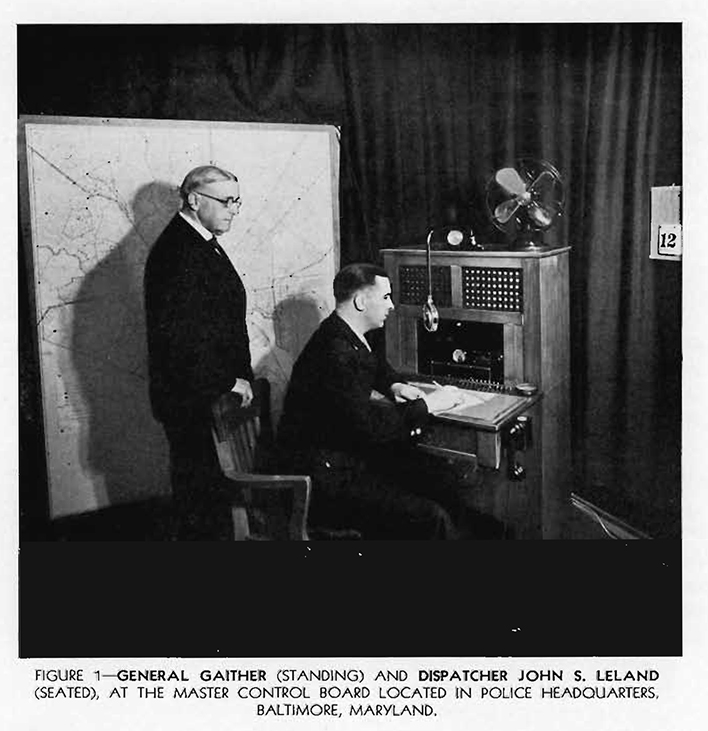
Gen Gaither has carefully plotted the radio districts for the city of Baltimore, much in the form of a spider web, with police headquarters in the center and the eight districts forming the sectors between the boundary lines radiating from that point. In each of these districts, radio equipped cars continually cruise and are continually in contact with radio headquarters. Four times an hour, radio headquarters sends out a test call at regular intervals of 10, 25, 40 and 55 minutes after the hour. (These particular times are chosen so as to avoid confliction with the test calls of certain other cities which are equipped with police radio systems.) Whenever an incident or an accident requiring the attention of the police is telephoned into headquarters, or to any of the other police stations throughout our city, the call is immediately broadcast over the radio system by the dispatcher on watch at the master Control Board, located in police headquarters. Here the dispatch can tell at a glance just what cars are available in each district to answer such alarms, and during the call which he sends out he directs certain cars to go to the location of the trouble. By means of very clever and unique system of lights controlled by key switches, he can tell at a glance what cars are available and what cars are already busy on other calls or “out of service.” at the left of his switchboard there is a Bank of green lights, each bearing a number, and at the right is a corresponding Bank of white lights bearing similar numbers. Every police “cruiser” car with is available is represented by green light on the left half of the board and whenever one of these cars is directed to answer an alarm, the operator at the Control Board throws a key switch bearing the number of this car, and immediately the corresponding green light on the left half of the board is extinguished and a white light on the right side of the board is illuminated, indicating that this particular car is busily engaged in answering an alarm. After the alarm has been answered and the case cleared up, one of the two men who operate this particular car telephone into police headquarters making a routine report on this subject, and they are then directed to return to their regular cruising activities. The dispatcher at the police headquarters then transfers this car back into “available service,” and by means of the key switch, the corresponding white light is extinguished on the right-hand side of the board and the green light reappears at the left side of the board.
Under ordinary circumstances, at present, there are 14 of these cars in active service, which means that there are 14 green lights appearing at the left side of the Control Board. The switchboard, however, has been designed and built with a view toward future expansion, and there are positions available for a total of 60 cars.
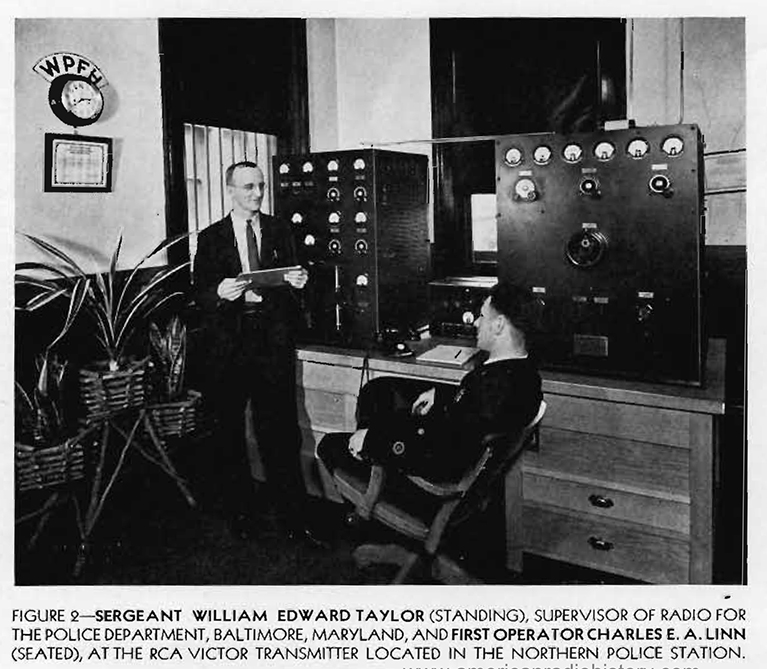
In addition to the colored light system just described, and a two-way telephone instrument, there is incorporated in the switchboard a microphone and a telephone amplifier for the voice line, which extends from police headquarters to the location of the 500-Watt transmitter, 4-1/2 miles distant, at the “northern” police station. At the northern PlayStation, and efficient and attractive installation has been made, including and RCA victor capital E capital T dash 3670 police alarm radio transmitter and a capital U capital T dash 4199, 400/500 white power amplifier modulator unit, all mounted on a specially constructed up desk. Between these two units there is also a telephone amplifier for the voice line connecting this point with police headquarters. Gazing out through one of the windows of the transmitter station, one may see the 70-foot wooden masts which supports the single wire transmitting antenna. This particular location was chosen after considerable time had been spent making surveys and field intensity measurements, and the results of the preliminary test have been confirmed by the excellent performance obtained in service.
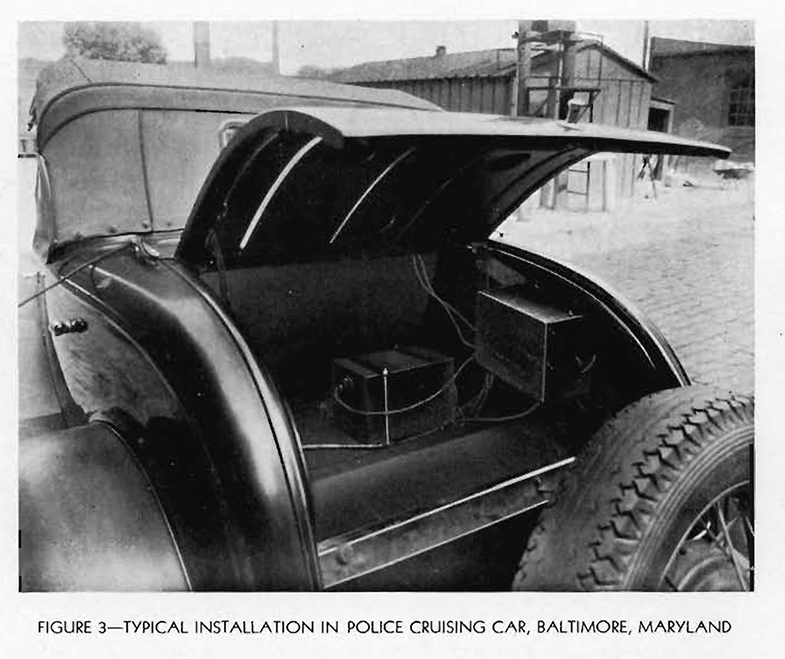
The transmitter itself is placed on the air only when accidentally needed, during the broadcasting of alarms and the regular test calls at 15-minute intervals and at other times it is kept in a standby position. Regular listening watches are maintained on a shortwave receiver at the transmitter station during the period described by the federal radio Commission.
Up to the present time, a total of 25 cars have been equipped with RCA victor police radio receivers, Copper screen Ant center insulations have been made in the tops of these cars, which makes for a very efficient operation. General Gaither hopes in the near future to have an additional 35 cars similarly equipped.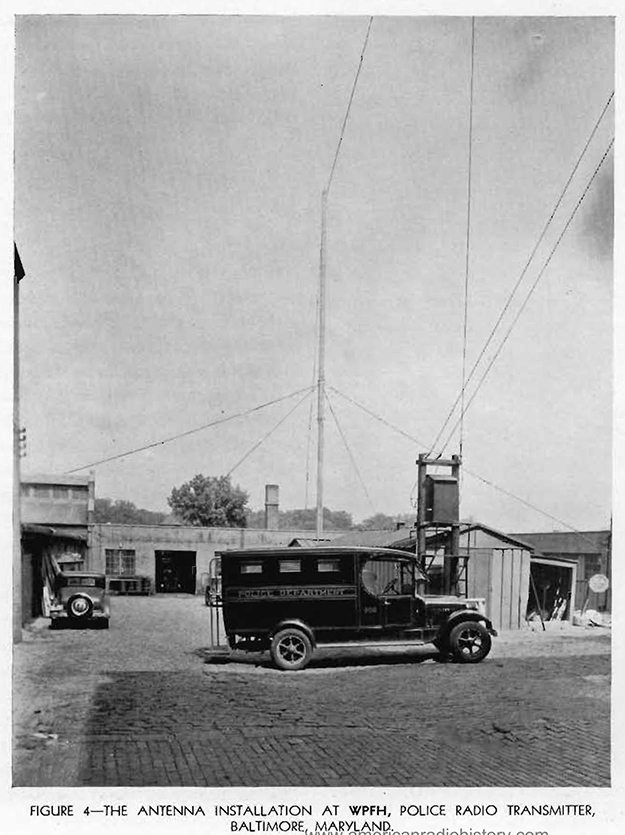
In the 91.7 square miles covered by the eight radio districts of both the more, there is a total of approximately 900,000 population. In cases of emergency, the 14 cars engaged in cruising throughout these eight districts may be sent to 14 fixed positions what's commands all the main arteries leading into and out of the city. This means that criminals attempting to make their escape by automobile would find all roads effectively blocked in every direction.
A very interesting feature at the master radio control room at police headquarters is the map of the city of Baltimore, in which thousands of little colored pens have been insert it. Each pin represents a police alarm which has been answered through the medium of radio since the inauguration of this system on 4 March 1933. These pins are in three different colors, one color representing alarms which occurred between 8:00 AM and 4:00 PM, another color representing alarms which occurred between 4:00 PM and midnight and the third color representing alarms that occurred between midnight and 8:00 AM thus at a glance may be seen the “busiest” districts and also one may analyze the busiest times throughout the 24-hour day. This information is of great importance in planning for future expansion and operations.

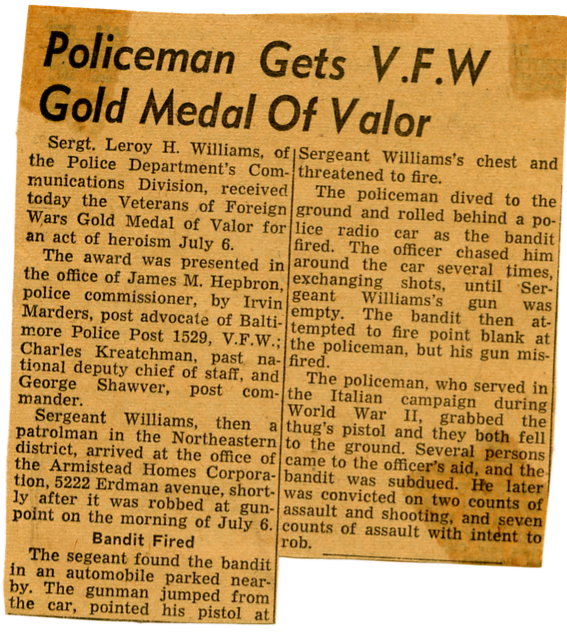
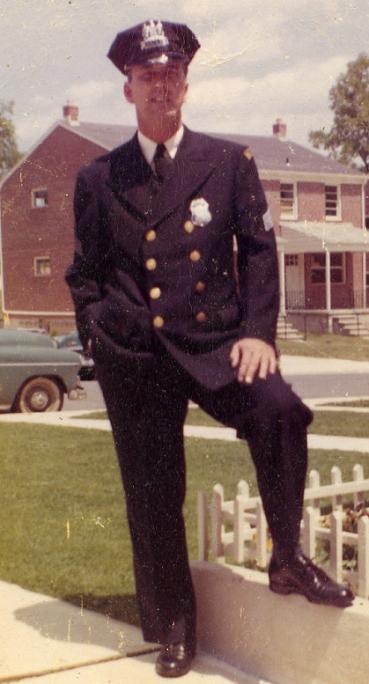
Sergeant LeRoy H. Williams
LeRoy H. Williams, born June 25, 1920, E.O.D. 1946, Retired L.O.D 1976, Passed away on March 17, 1990. He was assigned to the Northeast District, the old Headquarters building, and then Communication when they built the new building. When Major Norton retired he was in charge of Communication Division for a long time. He retired from Communication as a Lieutenant.
His son Paul J. Williams followed in his father's footsteps serving 20+ years with the Baltimore Police Department.
Lieutenant LeRoy H. Williams,
Commander of the Communications Division
during the mid-1970's
Sergeant Nelson Herman has 35 years of service with BPD, 28 years in the Communications Division
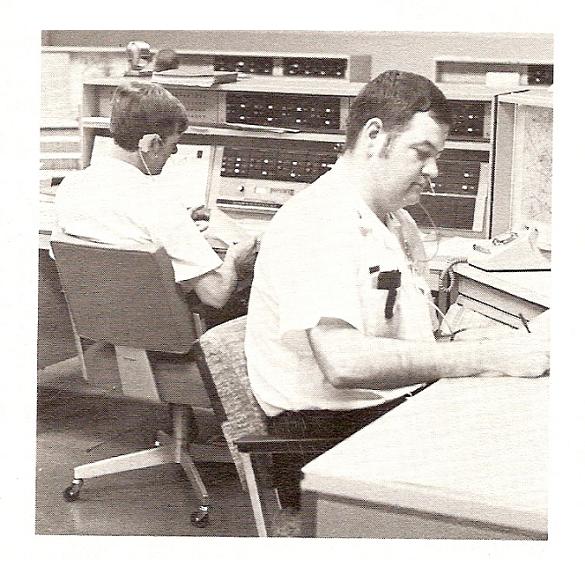
All Unit 10-6 unless you have a 10-33, stand by for a 10-36
Officer Dave Clauss (left) and Officer Gordon Amy (right) in the Communications Division 1978 dispatching patrol units.
Photo Courtesy Sgt. William Gordon
Captain Kenny Anderson pointing a gun at Sergeant Gordon the photographer as Sergeant Herman encourages him to shoot.
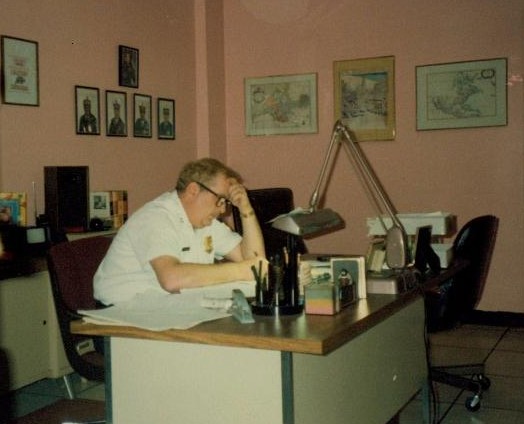
Photo Courtesy Sgt. William Gordon
Captain Kenny Anderson working diligently on a report
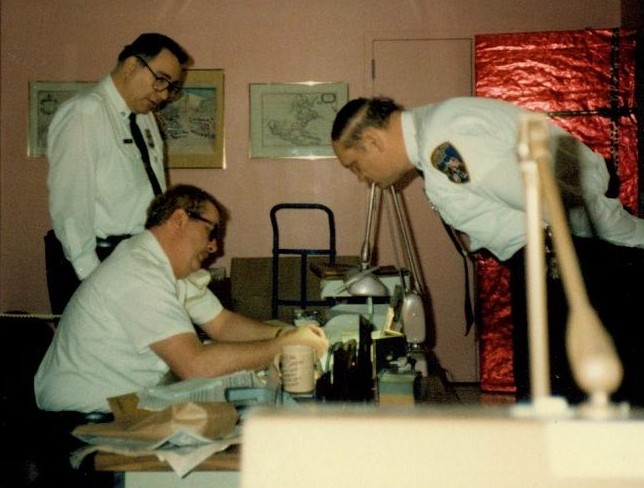
Photo Courtesy Sgt. William Gordon
Captain Kenny Anderson still working diligently on a report aided by Sergeant Herman and Spencer

Photo Courtesy Sgt. William Gordon
Sergeant Herman relaxing after helping Captain Anderson
Photo Courtesy Sgt. William Gordon
Gary Martin and Greg Cook
Photo courtesy Det. Lou Trimper
Detective Lou Trimper at the Western District radio console
Photo courtesy Det. Lou Trimper
Officer Wayne Mulaney at the radio console as Cadet Jack Long looks on
Photo courtesy Det. Lou Trimper
L-R Cadet Jack Long and Det. Lou Trimper at the radio console for Western District
Photo courtesy Det. Lou TrimperCadet Nick Constantine at the radio console
Photo courtesy Det. Lou Trimper
Cadet Jack Long dispatching patrol units.
Cadet Long rose through the ranks of the department attaining the rank of Major
Photo courtesy Det. Lou Trimper
TRU Telephone Reporting Unit
Photo courtesy Det. Lou Trimper
Det. Lou Trimper in the TRU
Click Either the Above or Below Pic to Go to Visit
The New Emergency Number Page 20 May 1967

Emergency Number 1967
222-3333
 The Following Pics came to us Courtesy of retired Lieutenant Robert Wilson
The Following Pics came to us Courtesy of retired Lieutenant Robert Wilson
311
16 March 1988
New Radio with Identifiers and Sig 13 Button
16 March 1988New Radio with Identifiers and Sig 13 Button
Printed 15 March 1985 in the Baltimore Sun

Click HERE on on the Article Above to see full size article
1996 - August 1996 - The Baltimore Police Department became the first ever with a non-emergency 311 system. - If the pilot program worked, the number would be used in other cities to offer residents an alternative way of getting assistance from their local police without tying up lines designed to quickly handle life-threatening emergency situations. The initial news reports began in July of 1996 and the program went into testing August of the same year.
1996 - 2 Oct 1996 - With a successful piolet program under its belt Baltimore becomes the first Police Department in the country to use the Non-Emergency 311 system. We had only started using 911 emergency number 11 years earlier on 1 March 1985

POLICE INFORMATION
Copies of: Your Baltimore Police Department Class Photo, Pictures of our Officers, Vehicles, Equipment, Newspaper Articles relating to our department and or officers, Old Departmental Newsletters, Lookouts, Wanted Posters, and or Brochures. Information on Deceased Officers and anything that may help Preserve the History and Proud Traditions of this agency. Please contact Retired Detective Kenny Driscoll.
This email address is being protected from spambots. You need JavaScript enabled to view it.

NOTICE
How to Dispose of Old Police Items
Please contact Det. Ret. Kenny Driscoll if you have any pictures of you or your family members and wish them remembered here on this tribute site to Honor the fine men and women who have served with Honor and Distinction at the Baltimore Police Department.
Anyone with information, photographs, memorabilia, or other "Baltimore City Police" items can contact Ret. Det. Kenny Driscoll at This email address is being protected from spambots. You need JavaScript enabled to view it. follow us on Twitter @BaltoPoliceHist or like us on Facebook or mail pics to 8138 Dundalk Ave. Baltimore Md. 21222
Copyright © 2002 Baltimore City Police History - Ret Det Kenny Driscoll










